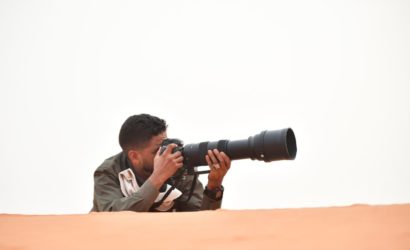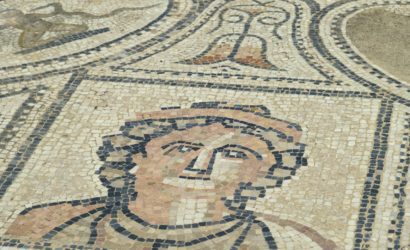Meknes
 Founded in the 11th Century, Meknes was once the grandest imperial city of all Morocco, and the imperial palace was at its heart. The largest building in the northern hemisphere for its time, its walls stretching for miles and enclosing meadows, orchards, and even pleasure gardens, was only the start of the vision of Sultan Moulay Ismail (1672–1727).
Founded in the 11th Century, Meknes was once the grandest imperial city of all Morocco, and the imperial palace was at its heart. The largest building in the northern hemisphere for its time, its walls stretching for miles and enclosing meadows, orchards, and even pleasure gardens, was only the start of the vision of Sultan Moulay Ismail (1672–1727).
 Simply called the “Dar Kbira” (The Big) was only part of the massive complex of fifty interconnected palaces. Every structure was grand and intricately decorated and included pillaged elements from the nearby Roman ruins of Volubilis. Even structures as mundane as the palace stables were the size of a small town. However, all the grandeur was only a tiny part of the Sultan’s grand plan. To rival the newly completed Palace of Versailles, he envisioned a place stretching 300 miles from Meknes to Marrakech with his sun emblem above every doorway.
Simply called the “Dar Kbira” (The Big) was only part of the massive complex of fifty interconnected palaces. Every structure was grand and intricately decorated and included pillaged elements from the nearby Roman ruins of Volubilis. Even structures as mundane as the palace stables were the size of a small town. However, all the grandeur was only a tiny part of the Sultan’s grand plan. To rival the newly completed Palace of Versailles, he envisioned a place stretching 300 miles from Meknes to Marrakech with his sun emblem above every doorway.
But under all the grandeur was a dark secret. Every mosaic, carving, column, and battlement was built by Christan slaves. Under Sultan Moulay Ismail, the Barbary Pirates grew and began raiding across the coast of Europe and as far away as Newfoundland and Greece. Once only raiding for treasure, they quickly discovered the value of the European slaves they were able to capture, and the sight of the Barbary Pirates struck fear into the hearts of all that saw their sails. From 1625 and lasting nearly two centuries, European slaves were bought and sold in Morocco and throughout the Barbary coast.
The great places and grand vision of the Sultan ended in 1755 when an earthquake destroyed in minutes what took decades to construct. The court fled, never to return, and the ruins were quickly inhabited by the poor of Meknes. What remains today are rare and important monuments located within a rapidly changing urban environment that gives this urban heritage its universal value.
Sahrij Swani
Although popularly thought to have been built by Moulay Ismail to sail pleasure boats inside the kasbah, the real reason is much more practical. This artificial lake was constructed to guarantee water supply in times of siege or drought to the palaces and mosques of the town, as well as to the public baths, homes, gardens, and orchards nearby.
Dar al-Ma
Also known as the “House of the Ten Norias,” it is a massive structure consisting of a large central chamber surrounded by smaller rooms around which, in turn, was a large vaulted corridor giving access to 15 domed chambers. Each domed chamber held a noria or mechanical system which drew water from a deep well via a series of pails or buckets chained together and raised by a horse-drawn wheel. This structure provided running water for the royal city through a system of terracotta pipes.
 Heri es-Swani
Heri es-Swani
A vast area of silos adjoining the House of the Ten Norias. The building is often called the “stables” or “royal stables” of Moulay Isma’il. However, it was an enormous grain storage warehouse that could stockpile supplies to withstand a long siege. Grain was delivered to the building by mules who climbed onto a roof terrace and dropped the grain directly into holes that were pierced in the vaulted roofs. One interior corridor remained free of grain to allow circulation inside the silos. Today, the vaulted ceilings have collapsed and disappeared, leaving only the numerous rows of arches, considered one of the most impressive sights in the city.
Mausoleum of Moulay Ismail
The Mausoleum complex was first built in 1703 under Moulay Ismail, but was modified and expanded multiple times. The original complex was less extensive than it is today, and its plan likely included only the tomb chamber, the adjoining rooms on either side of it, and the central courtyard leading up to it. The other courtyards and passages were added later. The mausoleum is still visited today by Moroccans seeking baraka (blessings or luck) from Moulay Ismail’s tomb.
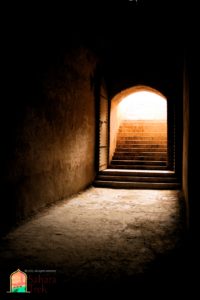 Habs Qara
Habs Qara
One of the lesser-known yet historically significant parts of Meknes is the Habs Qara (or Kara Prison), where Europeans enslaved by the Barbary Pirates were held. Built during the early 18th Century, this vast underground prison features no cells or bars but relied on its labyrinth-like design, which goes on for miles and may have been initially roughly the size of the city itself. Each hall of the dungeon contained several corridors leading to another hall, another, and then another. Named after a Portuguese prisoner who was granted freedom on the condition that he constructed a prison that could house more than 40,000 inmates. Today, a portion of the former prison is open to the public, but its actual size is still unknown.
Camel Caravan
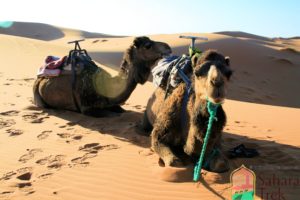
There’s something fantastic about camels that you never really understand until standing right in front of one. They’re big, over 6′ tall at the shoulders, and nearly 2/3 of a ton. They’re smart, remember kindness, and enjoy an affectionate scratch or pet (think of them as really big dogs with saddles). They’re also surprisingly photogenic and often will look right into the camera, ready for their closeup.
 Riding a camel takes no experience at all. Their size and feel resemble sitting on a felt-covered, substantial couch. Unlike the jarring up-down ride of a horse, the camel gently sways from side to side when it walks and never seems to be in a hurry. You also don’t have to steer a camel. Camels are pack animals and will follow the camel guide, who usually walks on foot in front.
Riding a camel takes no experience at all. Their size and feel resemble sitting on a felt-covered, substantial couch. Unlike the jarring up-down ride of a horse, the camel gently sways from side to side when it walks and never seems to be in a hurry. You also don’t have to steer a camel. Camels are pack animals and will follow the camel guide, who usually walks on foot in front.
If you think riding a camel is easy, you’d be right. It’s getting onto it is the adventure. You don’t mount a camel like you do a horse. The camels start by sitting down until you get in the saddle. That’s when the fun begins. Then, as the camel stands, its back legs straighten first, pitching the rider forward, then the front legs straighten, pitching the rider back. Then, when it kneels, it’s the same process in reverse. So remember, saddle up, lean back, then lean forward.
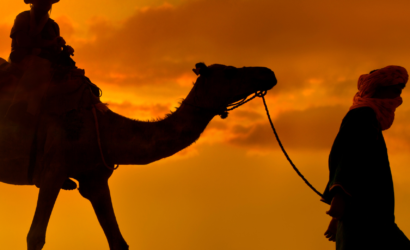
Deserts and Empires
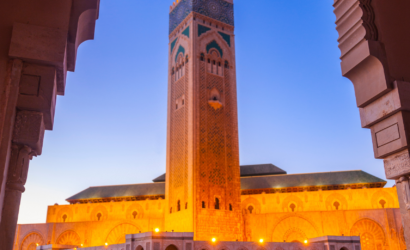
Ghost Tour of Fez
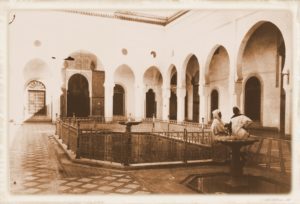 Over fourteen centuries have passed since the founding of Fez. One of the largest labyrinth cities in the world, the city has seen dynasties rise and fall, foreign invasion, conquest, bloody rebellion, and liberation. It’s an enigma, wrapped in a mystery, colored with hope, and tinted with blood. Guided tours of Fez focus on today and the city’s historical monuments and highlights, overlooking its colorful and sometimes dark past.
Over fourteen centuries have passed since the founding of Fez. One of the largest labyrinth cities in the world, the city has seen dynasties rise and fall, foreign invasion, conquest, bloody rebellion, and liberation. It’s an enigma, wrapped in a mystery, colored with hope, and tinted with blood. Guided tours of Fez focus on today and the city’s historical monuments and highlights, overlooking its colorful and sometimes dark past.
Now, for the first time in Morocco, SaharaTrek offers its exclusive guided Ghost Tour of Fez. Starting after dinner and just before sunset, you’ll get rare access to the places and stories left out of the tourist brochures.
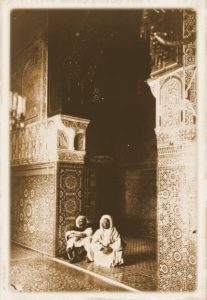 The tour starts before sunset with a look inside the abandoned Glaoui Palace. Once a sprawling complex of twelve houses, hammams, Qur’anic schools, stables, a cemetery, and extensive gardens, it was the base of power for the Glaoui family. As powerful as they were brutal, the Glaouis’ ambition knew no bounds. They became the enforcers for the French during the occupation (1907-1956) and conspired to overthrow Sultan Mohammed V. After Moroccan independence, the blood-soaked Glaoui family was erased from history, and their multiple palaces were seized and left to rot.
The tour starts before sunset with a look inside the abandoned Glaoui Palace. Once a sprawling complex of twelve houses, hammams, Qur’anic schools, stables, a cemetery, and extensive gardens, it was the base of power for the Glaoui family. As powerful as they were brutal, the Glaouis’ ambition knew no bounds. They became the enforcers for the French during the occupation (1907-1956) and conspired to overthrow Sultan Mohammed V. After Moroccan independence, the blood-soaked Glaoui family was erased from history, and their multiple palaces were seized and left to rot.
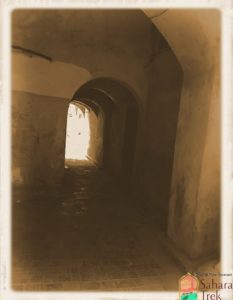 As the sun sets, you’ll be driven to the hills overlooking Fez as the call to prayer echoes from a hundred mosques before heading down into the Madina. You’ll venture by foot, following your guide down the narrow, dark alleys before arriving at the Slave Market.
As the sun sets, you’ll be driven to the hills overlooking Fez as the call to prayer echoes from a hundred mosques before heading down into the Madina. You’ll venture by foot, following your guide down the narrow, dark alleys before arriving at the Slave Market.
Slavery was abolished in Morocco in 1925, but its shadow still lingers in the Fez Medina at the Slave Market. During the day, they auction animal hides from the tannery in the market. In the afternoon, it’s a market for used clothes. But it’s when the market is empty at night that you can faintly hear the wails of despair from enslaved Christians taken by the Barbary Pirates or the sub-Saharan Africans brought over the Salt Road.
A short 2 hours after the tour starts and the darkest of the night has set in, you’ll be guided back to your Raid for the rest of the evening.

Deserts and Empires

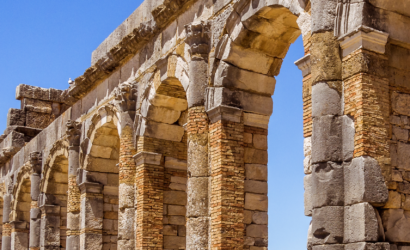
Ancient Empires
Guided Walking Tours
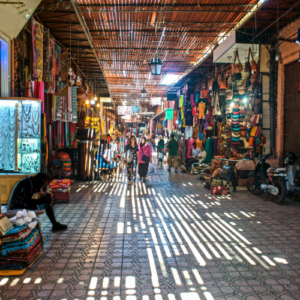 Are you ready to embark on an unforgettable journey through the vibrant cities of Morocco? All SaharaTrek tours include guided walking tours of Morocco’s most famous and historical cities, so you experience the country like never before. Immerse yourself in Morocco’s rich culture, history, and beauty as you explore its bustling streets, hidden gems, and iconic landmarks on foot.
Are you ready to embark on an unforgettable journey through the vibrant cities of Morocco? All SaharaTrek tours include guided walking tours of Morocco’s most famous and historical cities, so you experience the country like never before. Immerse yourself in Morocco’s rich culture, history, and beauty as you explore its bustling streets, hidden gems, and iconic landmarks on foot.
Our walking tours give you the unique opportunity to truly connect with the local communities, interact with friendly locals, and witness their daily way of life up close. Feel the city’s rhythm as you stroll through the colorful markets, savor the tantalizing aromas while sampling traditional cuisine, and marvel at the stunning architecture that tells the story of centuries past.
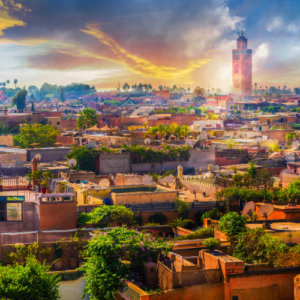 Unlike other ways of seeing the cities, walking allows you to discover the hidden corners and narrow alleyways inaccessible to larger vehicles. You’ll stumble upon charming riads, tranquil gardens, and secret courtyards that hold the secrets of Morocco’s enchanting past.
Unlike other ways of seeing the cities, walking allows you to discover the hidden corners and narrow alleyways inaccessible to larger vehicles. You’ll stumble upon charming riads, tranquil gardens, and secret courtyards that hold the secrets of Morocco’s enchanting past.
Our expert guides will lead you through the labyrinthine medinas, sharing fascinating stories and historical insights along the way. They’ll take you off the beaten path, introducing you to local artisans, craftsmen, and storytellers who will enrich your understanding of Moroccan culture.
The best part? You’ll have the freedom to pause, take photos, and explore each city at your own pace while you soak in the ambiance. You’ll get all the sights and sounds without feeling rushed or overwhelmed. And with a knowledgeable guide by your side, you’ll have a safe and enjoyable experience that you won’t soon forget.
Walking also provides a more sustainable and eco-friendly way to explore the cities, reducing your carbon footprint while immersing yourself in the authentic atmosphere of Morocco.
So, if you’re seeking an immersive adventure that goes beyond the surface, lace-up your walking shoes and discover the heart and soul of this captivating country, one step at a time.

Deserts and Empires


Ancient Empires
Hassan II Mosque
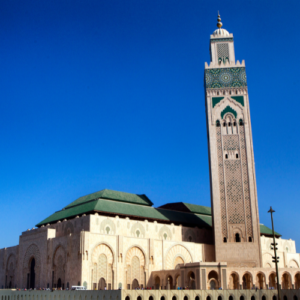 The Hassan II Mosque is the largest functioning mosque in Africa and the seventh largest in the world. It is a stunning example of Moorish architecture, with its intricate zellige tilework, carved cedar ceilings, and soaring minaret. The mosque is located on a promontory overlooking the Atlantic Ocean, and its location makes it even more impressive.
The Hassan II Mosque is the largest functioning mosque in Africa and the seventh largest in the world. It is a stunning example of Moorish architecture, with its intricate zellige tilework, carved cedar ceilings, and soaring minaret. The mosque is located on a promontory overlooking the Atlantic Ocean, and its location makes it even more impressive.
As part of a SaharaTrek tour, you can visit the Hassan II Mosque and learn about its history and significance. You will also have the opportunity to explore the interior of the mosque, which is open to non-Muslims. Our tour guides will ensure that you have a respectful and informative visit.
Here are some of the things you can expect during your visit to the Hassan II Mosque:
- Be dazzled by the mosque’s exterior, with its white marble walls and towering minaret.
- Marvel at the intricate zellige tilework in the interior, which is made up of millions of pieces of colored tile.
- Stand in the prayer hall, which can accommodate up to 25,000 worshippers.
- Take in the views of the Atlantic Ocean from the mosque’s terrace.
- Learn about the history of the mosque and its significance in Moroccan culture.
A visit to the Hassan II Mosque is a truly unforgettable experience. It is a must-see for anyone interested in Islamic architecture or Moroccan culture.
Here are some tips for visiting the Hassan II Mosque:
- The mosque is open to non-Muslims, but you will need to be respectful of Islamic customs.
- Be sure to dress modestly.
- Remove your shoes before entering the mosque.
- Tours are available in a variety of languages.
- The mosque is busiest during prayer times, so it is best to visit outside of these times.

Deserts and Empires


Ancient Empires
Ksar el Khorbat
Ksar el Khorbat Museum is located in the south of the Atlas Mountains. Originally built in the 17th century as a fortress to protect the surrounding area from invaders. Over time, it became a center of trade and commerce and was eventually transformed into a kasbah museum.
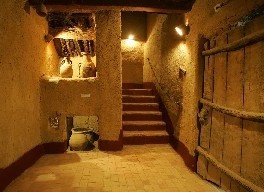 Today, the Kasbah Museum is a fascinating place to visit, filled with artifacts and exhibits that tell the story of the people who lived there. You’ll have the chance to see everything from traditional Berber clothing and jewelry to weapons and tools used by the local tribes.
Today, the Kasbah Museum is a fascinating place to visit, filled with artifacts and exhibits that tell the story of the people who lived there. You’ll have the chance to see everything from traditional Berber clothing and jewelry to weapons and tools used by the local tribes.
In addition to the museum, the restaurant offers traditional camel meat dishes as delicious as it is authentic.
A visit to Ksar el Khorbat Kasbah Museum is a truly unique and unforgettable experience. Its fascinating history, stunning architecture, and rich cultural heritage will leave a lasting impression on anyone who visits. S

Deserts and Empires

Self-Guided Adventure
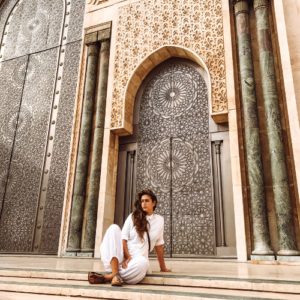 SaharaTrek offers a unique opportunity for travelers to experience Morocco’s vibrant culture and history beyond the tour. Our guided tours provide you with a comprehensive exploration of the country’s most iconic sites, including the bustling marketplaces, ancient ruins, and breathtaking landscapes. But we also understand that sometimes, you want to explore on your own, without the constraints of a guided tour. That’s why we offer free time after our guided tours, ensuring that you have the flexibility to explore the cities and discover their hidden gems.
SaharaTrek offers a unique opportunity for travelers to experience Morocco’s vibrant culture and history beyond the tour. Our guided tours provide you with a comprehensive exploration of the country’s most iconic sites, including the bustling marketplaces, ancient ruins, and breathtaking landscapes. But we also understand that sometimes, you want to explore on your own, without the constraints of a guided tour. That’s why we offer free time after our guided tours, ensuring that you have the flexibility to explore the cities and discover their hidden gems.
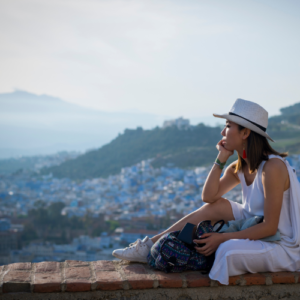 With free time on your hands, you can take advantage of the many attractions in the city, such as the bustling markets, historical sites, gardens, and charming cafes that aren’t covered during the tour. You can also dine at local restaurants, shop for souvenirs, or simply wander through the streets and soak up the vibrant energy of the city. With SaharaTrek, you can enjoy the best of both worlds – a guided tour that provides a comprehensive overview of the country’s highlights and free time to explore on your own, allowing you to truly experience the culture and spirit of Morocco.
With free time on your hands, you can take advantage of the many attractions in the city, such as the bustling markets, historical sites, gardens, and charming cafes that aren’t covered during the tour. You can also dine at local restaurants, shop for souvenirs, or simply wander through the streets and soak up the vibrant energy of the city. With SaharaTrek, you can enjoy the best of both worlds – a guided tour that provides a comprehensive overview of the country’s highlights and free time to explore on your own, allowing you to truly experience the culture and spirit of Morocco.

Deserts and Empires


Ancient Empires
Shopping
Discover Morocco’s vibrant and exotic shopping world, where centuries-old traditions meet contemporary trends. Morocco offers a unique and unforgettable shopping experience for travelers with its bustling markets, artisanal craftsmanship, and a kaleidoscope of colors and scents.
Medina Souks: A Shopper’s Paradise
 Explore the enchanting medinas (old city centers) of Marrakech, Fez, and Essaouira, where you’ll find labyrinthine alleys filled with a treasure trove of goods.
Explore the enchanting medinas (old city centers) of Marrakech, Fez, and Essaouira, where you’ll find labyrinthine alleys filled with a treasure trove of goods.- Discover handmade rugs, intricate ceramics, dazzling lamps, and intricately designed textiles.
- Bargain to your heart’s content and immerse yourself in the lively atmosphere of these ancient marketplaces.
Traditional Souvenirs: Moroccan Keepsakes
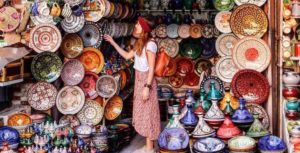 Bring home a piece of Morocco with traditional souvenirs like ornate tea sets, decorative tagines, and beautiful mosaic works.
Bring home a piece of Morocco with traditional souvenirs like ornate tea sets, decorative tagines, and beautiful mosaic works.- Handcrafted leather goods such as bags, belts, and shoes are also popular choices.
- Don’t forget to pick up some argan oil, known for its nourishing properties and unique to Morocco.
The Art of Haggling: Bargaining Tips
- Haggling is a cultural norm in Morocco, so embrace it with a smile and negotiate for the best prices.
- Be friendly and respectful during negotiations, and don’t be afraid to walk away if a deal doesn’t feel right.
- There are four steps to successful Moroccan negotiating:
- First Price: That’s the price you’ll be given with a smile. It’s more of a suggestion (or wishful thinking) for the shopkeeper.
- First Offer: Knowing how much you want to pay is essential. A good way to educate yourself is to stop by the Centre Artisanal (a government-run, no-haggle shopping plaza). The prices and quality are the price to beat, so make your first offer lower than what you’ve seen there.
- The Yelling Phase: The shopkeeper will become outraged at the price you’ve offered and begin to toute the quality of the products and how he won’t make any money at the price you offered and will make a counteroffer.
- Make or Break: As the asking price decreases, the offering price increases (but not past what you want to spend). At this point, you’d better be sure you want that item at the price you say because if the shopkeeper agrees, then you MUST pay the price you offered (it’s offensive not to).
- During serious big-ticket haggling, you’ll be offered mint tea from the shopkeepers, a gesture of goodwill during negotiations and a way to keep you longer. There’s a joke: every glass of tea adds $10 to the purchase price.
Fashion and Jewelry: Moroccan Elegance
- A
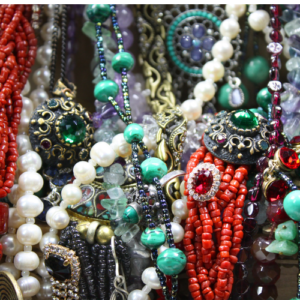 dmire the craftsmanship of Berber and Tuareg jewelry, often adorned with semi-precious stones and intricate silverwork.
dmire the craftsmanship of Berber and Tuareg jewelry, often adorned with semi-precious stones and intricate silverwork. - Don’t miss the vibrant kaftans, jalabiyas, and djellabas, traditional Moroccan garments with modern twists.
Artisan Workshops: A Glimpse into Craftsmanship
- On our guided tours, you’ll visit artisan workshops and witness the skillful creation of Moroccan goods.
- Learn about the art of pottery, weaving, metalwork, and woodworking from skilled craftsmen.
- Purchase one-of-a-kind pieces directly from the artisans.
Markets by Region: Diversity in Shopping
- Explore the uniqueness of each region’s markets, from thuya wood and argon oil in Essaouira to hand-tanned leather in Fez.
- Discover regional specialties, like hand-painted ceramics in Safi or carpets in the Middle Atlas region.
Shopping in Morocco is an adventure in itself, where you can immerse yourself in this enchanting country’s rich culture, artistry, and history. Morocco offers a shopping experience that will leave you with not just souvenirs but lasting memories of a unique and diverse culture.

Deserts and Empires


Ancient Empires
Spas & Riads
SaharaTrek offers a wide range of tours and activities to help you explore the best of this beautiful country. We understand that your accommodation is an important part of your trip, and we only partner with the best riads and hotels in Morocco.
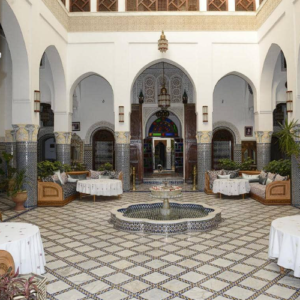 A riad is a traditional Moroccan house or palace with an interior garden or courtyard. Riads are typically located in the medina, or old city, of Moroccan cities. They are known for their beautiful architecture, intricate zellige tilework, and relaxing atmosphere. Riads offer a unique and authentic Moroccan experience.
A riad is a traditional Moroccan house or palace with an interior garden or courtyard. Riads are typically located in the medina, or old city, of Moroccan cities. They are known for their beautiful architecture, intricate zellige tilework, and relaxing atmosphere. Riads offer a unique and authentic Moroccan experience.
In addition, many of our riads offer an optional luxury hammam (spa) experience because they know that their guests will appreciate the benefits of this traditional Moroccan experience. Hammams are a great way to relax and rejuvenate after a long day of sightseeing or exploring. They are also a great way to connect with Moroccan culture and tradition.

Deserts and Empires


Ancient Empires
Taste of Morocco
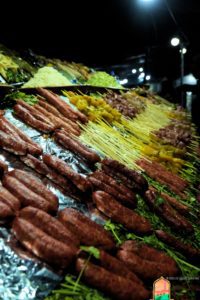 Here’s a joke: What do Moroccans call traditional Moroccan food? Answer: Food! And traditional Moroccan food is everywhere you go, surrounding you with the smells and tastes of the exotic. With our Taste of Morocco, you’ll experience the adventure that is Moroccan street food. In Marrakech and Fez, your tour guide will not only show you the sites of Moroccan culture and history, feeding your curiosity and desire for adventure. But also stop by the small shops and workingman’s cafes where you’ll get to sample the local delicacies feeding your stomach simultaneously. Think of it as a city-wide roving buffet that can easily replace a sit-down lunch.
Here’s a joke: What do Moroccans call traditional Moroccan food? Answer: Food! And traditional Moroccan food is everywhere you go, surrounding you with the smells and tastes of the exotic. With our Taste of Morocco, you’ll experience the adventure that is Moroccan street food. In Marrakech and Fez, your tour guide will not only show you the sites of Moroccan culture and history, feeding your curiosity and desire for adventure. But also stop by the small shops and workingman’s cafes where you’ll get to sample the local delicacies feeding your stomach simultaneously. Think of it as a city-wide roving buffet that can easily replace a sit-down lunch.
As you tour the cities, keep your eyes (and noses) on the lookout for some of the specialties Morocco offers, and you’ll regret missing them.
- Shebbakia: pasta ribbons with hot honey and grilled sesame seeds, commonly found during Ramadan.
- Briouats: sweet filo pastry with a savory filling, like a miniature pasilla.
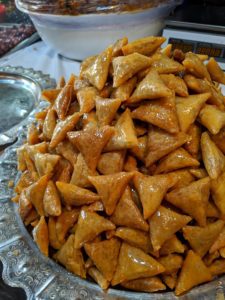 Briouats au miel: sweet filo pastry envelopes filled with nuts and honey.
Briouats au miel: sweet filo pastry envelopes filled with nuts and honey.- M’hencha: almond-filled pastry coils, often covered in honey or syrup.
- Cornes de gazelle: marzipan-filled, banana-shaped pastry horns.
- Pastilla: sweet pigeon or chicken pie with cinnamon and filo pastry (a specialty of Fes).
- M’laoui: flat griddle bread from dough sprinkled with oil, rolled out, and folded several times.
- Bissara: thick beans soup, usually served with olive oil and cumin.
- Olives: come in numerous varieties,
- Almonds, walnuts, and dates.
- Bread: almost always round like a cake and tears easily by hand. It’s usually homemade and cooked in the public oven.
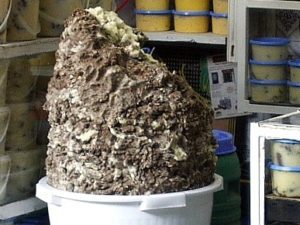 Khlea: small pieces of beef or lamb marinated in light spices, then dried in the sun (gueddid) before being cooked and preserved in fat for up to 2 years. Still a homemade staple in rural areas, these days, many Moroccan families resort to buying it as it is so readily available everywhere.
Khlea: small pieces of beef or lamb marinated in light spices, then dried in the sun (gueddid) before being cooked and preserved in fat for up to 2 years. Still a homemade staple in rural areas, these days, many Moroccan families resort to buying it as it is so readily available everywhere.

Deserts and Empires


Ancient Empires
Todra Gorge Hike
Enjoy an adventure-filled 3-hour hike along the stunning Todra Gorge!
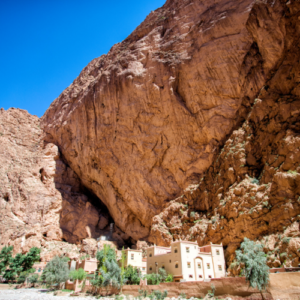 Nestled in the heart of the High Atlas Mountains, the Todra Gorge is a must-see destination for anyone who loves nature and outdoor activities. With towering rock walls that reach over 300 meters high, this gorge is a sight to behold.
Nestled in the heart of the High Atlas Mountains, the Todra Gorge is a must-see destination for anyone who loves nature and outdoor activities. With towering rock walls that reach over 300 meters high, this gorge is a sight to behold.
On our 3-hour hike (included with the cost of your tour), you’ll get to explore the beauty of the Todra Gorge up close. Our experienced guides will lead you on a scenic trail that winds through the gorge, offering breathtaking views of the surrounding mountains and valleys. Along the way, you’ll have plenty of opportunities to stop and take photos and learn about the local flora and fauna.
At SaharaTrek, we pride ourselves on providing safe and enjoyable experiences for all. Whether you’re a seasoned hiker or just starting out, we guarantee that you’ll have a great time exploring the Todra Gorge with us. If hiking is too strenuous, donkeys are available at an extra charge to make the adventure accessible to all.

Deserts and Empires

